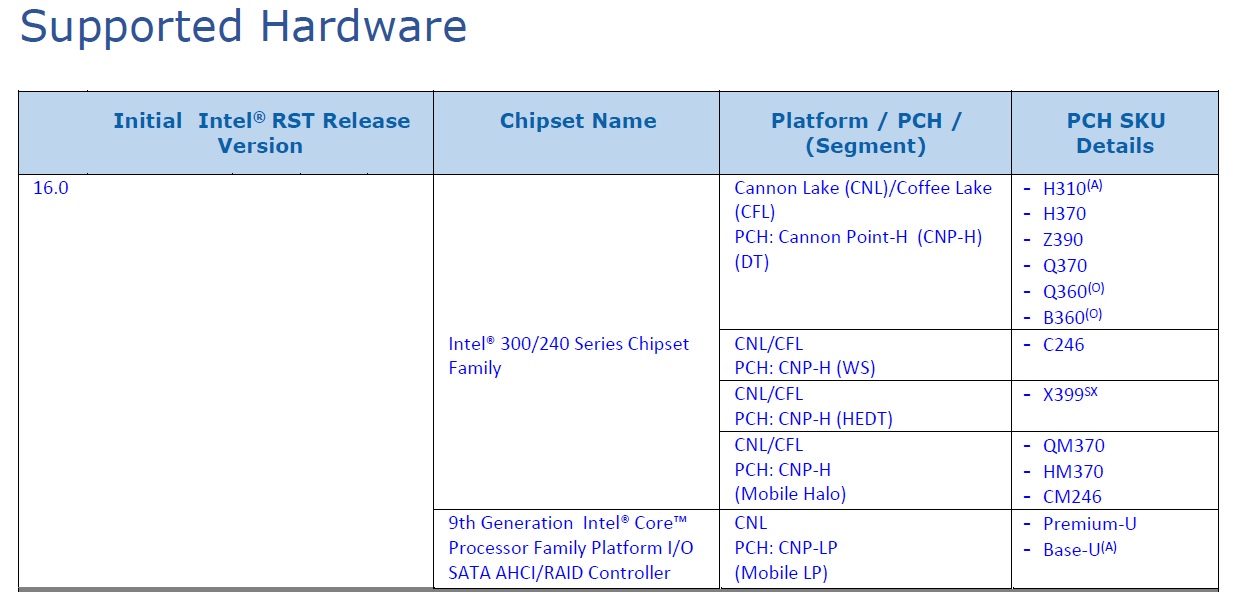Intel Document Leaks X399, Confirms Cannon Lake Support For Z390
The release notes for a version of Intel Rapid Storage Technology (pictured above) leaked some interesting tidbits of information about some upcoming Intel desktop platforms.
First of all, the document mentions the much-discussed Z390 chipset that will allegedly replace the dated Z370 as the highest-end mainstream desktop chipset for Coffee Lake. There have already been plenty of leaks confirming the existence of Z390, but the new document states that the chipset will also support Cannon Lake processors. Unlike Intel’s current Coffee Lake processors that are fabricated on a 14nm process, Cannon Lake will be the first processors to use Intel’s long-in-development 10nm process.
The first Cannon Lake processors were set to release in 2017, but that didn’t happen. Early this year, Intel confirmed that it had shipped a small amount of 10nm parts, but the company has yet to make any official announcement of a Cannon Lake product.
The second big reveal in the document is the existence of a successor to the X299 chipset. A new high-end desktop (HEDT) chipset called the X399 is coming. That name is the same as AMD’s existing X399 chipset that the Threadripper processors use. When AMD took the name “B350” before Intel did, Intel chose to use “B360” instead. It looks like Intel isn’t backing down this time, so we don’t know how this situation of overlapping names will work out.
Intel’s X399 is listed as supporting Coffee Lake and Cannon Lake. Currently, X299 is the home of Skylake-X and Kaby Lake-X parts; there are no Coffee Lake-branded parts for that platform. The previously known successor to Skylake-X was Cascade Lake-X. Because the name Cascade Lake comes from the Xeon product line, it’s possible that Intel has chosen to rename those parts as Coffee Lake-X.
The X299 chipset and its socket, LGA 2066, is only a year old, so we don’t expect X399 to use a different socket.
Get Tom's Hardware's best news and in-depth reviews, straight to your inbox.
-
Giroro "The X299 chipset and its socket, LGA 2066, is only a year old, so we don’t expect X399 to use a different socket."Reply
They might as well make a new socket, since Intel doesn't allow new chips to function in motherboards that are only a year old. -
svan71 Exactly, the z270 z370 scam the 1150 1151 b.s. perfect examples though the former was especially disgusting. I want a refund for lost performance due to meltdown/spectre.Reply -
compprob237 Reply20916924 said:AMD stole their name. The naming scheme is tainted now due to that copycat with x370 and x399. They might as well use a new.
Yes, AMD should change it since Intel will taint "X399" with a platform that will only be useful for less than a year whereas AMD's will be good for 2 years or more. -
kinggremlin Reply20917304 said:20916924 said:AMD stole their name. The naming scheme is tainted now due to that copycat with x370 and x399. They might as well use a new.
Yes, AMD should change it since Intel will taint "X399" with a platform that will only be useful for less than a year whereas AMD's will be good for 2 years or more.
Way to spread lies or just demonstrate your lack of knowledge. Intel's HEDT chipsets have always been current for multiple years.
x58: Nov 2008 - Nov 2011
x79: Nov 2011 - Aug 2014
x99: Aug 2014 - Jun 2017
x299: Jun 2017 - ? At least 2019
That's the previous 4 generations, each one lasting no less than 2 years 9 months before getting replaced. -
Kahless01 its less than a year old so you dont expect intel to change sockets? you silly man. you know intels gotta get those profits coming in. id be more shocked if it kept the same oneReply -
Co BIY I disagree that Z270-Z370 was a rip off by Intel. Supporting 6 high performance cores instead of 4 has to take a better set up and needed differentiation.Reply
The slow roll out of the H and B chip sets was painful but I suspect hurt Intel more than anyone else. It would have been much better for them to have been out long before the refreshed Ryzen + line. -
compprob237 Reply20917863 said:20917304 said:20916924 said:AMD stole their name. The naming scheme is tainted now due to that copycat with x370 and x399. They might as well use a new.
Yes, AMD should change it since Intel will taint "X399" with a platform that will only be useful for less than a year whereas AMD's will be good for 2 years or more.
Way to spread lies or just demonstrate your lack of knowledge. Intel's HEDT chipsets have always been current for multiple years.
x58: Nov 2008 - Nov 2011
x79: Nov 2011 - Aug 2014
x99: Aug 2014 - Jun 2017
x299: Jun 2017 - ? At least 2019
That's the previous 4 generations, each one lasting no less than 2 years 9 months before getting replaced.
Now do that for Z-series and sockets. Especially the Z270 to Z370 and the new Z390 (Bonus round: Socket on all these even back to Z170 vs their CPU support). Meanwhile, AMD's plans are possible changes to chipsets (Recent X470, which was just moving from PCI-E 2.0 links to PCI-E 3.0) but maintaining the AM4/TR4 socket. The entire point was a snarky criticism of Intel's short-lived sockets and chipsets. A point which flew right over your head by taking it literally. :sarcastic:
